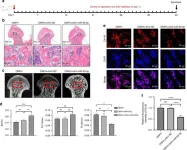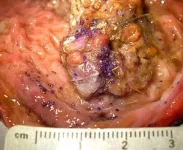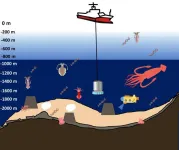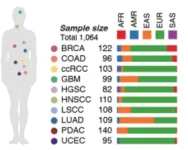(Press-News.org) A recent study has uncovered a potential breakthrough in treating osteonecrosis of the femoral head (ONFH), a debilitating bone disease that causes severe pain and joint collapse. Researchers have discovered that exosomes derived from M2 macrophages-derived exosomes (M2-Exos) can significantly improve bone regeneration by modulating neutrophil extracellular traps (NETs) and endothelial cell function. These tiny vesicles, packed with miR-93-5p, were shown to reduce harmful NETs formation and enhance blood vessel growth, offering a novel therapeutic approach. This discovery highlights the potential of M2-Exos to address the root causes of ONFH, paving the way for non-invasive treatments that could prevent bone deterioration and improve patient outcomes.
Osteonecrosis of the femoral head (ONFH) is a progressive condition where bone tissue dies due to disrupted blood flow, often leading to joint collapse and requiring invasive surgeries like hip replacement. Current treatments primarily focus on symptom management but fail to halt the progression of the disease. Recent studies suggest that immune dysfunction, particularly the activation of neutrophils and the formation of neutrophil extracellular traps (NETs), plays a critical role in ONFH by damaging blood vessels and triggering bone cell death. Additionally, endothelial-to-mesenchymal transition (EndoMT) exacerbates tissue damage by impairing blood supply. Despite advances, the molecular mechanisms linking immune cells and bone degeneration remain unclear. Given these challenges, there is an urgent need for therapies that can disrupt NETs formation and restore vascular health in ONFH.
Published (DOI: 10.1038/s41413-025-00412-5) on April 1, 2025, in Bone Research, a study led by researchers from Xi'an Jiaotong University and Zhejiang University School of Medicine reveals how M2 macrophages-derived exosomes (M2-Exos) can treat ONFH. Using single-cell RNA sequencing and animal models, the team demonstrated that M2-Exos deliver miR-93-5p, which suppresses NETs formation and reverses endothelial dysfunction. This study provides the first evidence of exosome-mediated communication between immune and bone cells, offering a promising strategy to combat osteonecrosis without invasive procedures.
The study's key findings reveal a promising therapeutic breakthrough for ONFH through the innovative use of M2-Exos. Using advanced single-cell RNA sequencing, researchers identified neutrophils as central players in ONFH progression, demonstrating how their formation of NETs contributes to vascular damage and bone cell death. The team made the remarkable discovery that M2-Exos, loaded with miR-93-5p, can effectively target and reduce harmful NETs formation by approximately 50% while simultaneously promoting angiogenesis through increased VEGFA expression. Through both in vitro and in vivo experiments, including rat models of ONFH, the study showed these natural vesicles precisely home to damaged bone tissue, where they deliver their therapeutic payload, demonstrating a dual mechanism of action that addresses both immune dysfunction and vascular impairment underlying the disease. The team further validated these findings by developing an adeno-associated virus (AAV) gene therapy to overexpress miR-93-5p, which replicated the beneficial effects seen with M2-Exos treatment. Notably, the treatment restored bone density, reduced empty osteocytic lacunae, and improved trabecular bone structure, offering compelling evidence for its potential clinical application. These results represent a significant advancement in understanding and potentially treating ONFH, providing a foundation for developing non-invasive therapies that could prevent disease progression and avoid the need for joint replacement surgery.
Dr. Pei Yang, co-corresponding author, stated, "Our findings reveal a previously unrecognized link between neutrophil NETs and bone necrosis. By harnessing M2-Exos, we've developed a precision tool to interrupt this vicious cycle. The ability of miR-93-5p to dual-target NETs and endothelial dysfunction could transform ONFH treatment paradigms." An independent expert not involved in the study added, "This work elegantly bridges immunology and orthopedics, offering a scalable solution for a disease with limited options."
This research opens avenues for exosome-based therapies in ONFH and other ischemic bone diseases. Clinically, M2-Exos could be administered via injection to halt early-stage osteonecrosis, delaying or avoiding joint replacement. Beyond ONFH, the miR-93-5p mechanism may apply to conditions like atherosclerosis or diabetic ulcers, where NETs and endothelial damage coexist. Challenges remain, such as optimizing exosome production and ensuring long-term safety. Future steps will include human trials and exploring synergies with existing drugs. If successful, this approach could shift treatment from surgical intervention to regenerative medicine, offering a new lease on life for millions of patients worldwide.
###
References
DOI
10.1038/s41413-025-00412-5
Original Source URL
https://doi.org/10.1038/s41413-025-00412-5
Funding information
This work was supported by the National Natural Science Foundation of China (Grant No.82272503) and Natural Science Foundation of Zhejiang Province (Grant No. LQN25H060006) as well as all individuals participating in this study.
About Bone Research
Bone Research was founded in 2013. As a new English-language periodical, Bone Research focuses on basic and clinical aspects of bone biology, pathophysiology and regeneration, and supports the foremost discoveries resulting from basic investigations and clinical research related to bone. The aim of the Journal is to foster the worldwide dissemination of research in bone-related physiology, pathology, diseases and treatment.
END
Immune cell 'messengers' could save crumbling bones - new hope for joint pain sufferers
2025-04-14
ELSE PRESS RELEASES FROM THIS DATE:
Fishing for cephalopod DNA allows for efficient marine surveying
2025-04-14
New DNA probes allow for efficient surveying of the hidden lives of squids and octopuses in the deep sea. This development by Kobe University provides an effective tool for marine ecological research and conservation efforts.
Squids and octopuses eat and are eaten, and in between that they move around a lot. “Cephalopods play an important role in marine ecosystems, contributing to the distribution of energy and nutrients in the food web,” explains Kobe University marine ecologist WU Qianqian. And while for ecological research it is therefore essential to know about the distribution ...
Having a 'therapist in your pocket' curbs depression among primary care patients
2025-04-14
Patients with depression who received the Moodivate app saw clinically meaningful reductions in their symptoms that were twice those achieved with standard-of-care therapy in a clinical trial conducted at 22 primary care practices in Charleston, South Carolina. App users were also 3 times more likely to achieve a clinically meaningful improvement in their depression and 2.3 times more likely to attain depression remission. Moodivate (available on both iOS and Android) is a digital version of behavioral activation, a type of behavioral therapy that has proved effective against depression. Jennifer Dahne, Ph.D., professor in the Department of Psychiatry and Behavioral ...
Hospital visits for cannabis use linked to higher dementia risk, study finds
2025-04-14
Ottawa, ON, April 14, 2025 – Individuals with an emergency department (ED) visit or hospitalization due to cannabis were at 23% and 72% greater risk of a new dementia diagnosis within five years compared to individuals with an ED visit or hospitalization for any other reason or the general population, according to a new study published in JAMA Neurology.
“Long-term and heavy cannabis use has been associated with memory problems in midlife along with changes in brain structure associated with dementia,” says Dr. Daniel Myran, a Canada Research Chair in Social ...
Recently discovered immune cell type is key to understanding food allergies
2025-04-14
The immune system must be able to quickly attack invaders like viruses, while also ignoring harmless stimuli, or allergies can result. Immune cells are known to ignore or “tolerate” molecules found on the body’s own healthy cells, for instance, as well as nonthreatening substances from outside the body like food. How the system achieves the latter has been unclear.
Now, a new study led by researchers at NYU Langone Health has revealed that a special group of cells in the intestines tamp down the immune responses caused by exposure to food proteins. ...
Projected lifetime cancer risks from current computed tomography imaging
2025-04-14
About The Study: This study found that at current utilization and radiation dose levels, computed tomography examinations in 2023 were projected to result in approximately 103,000 future cancers over the course of the lifetime of exposed patients. If current practices persist, computed tomography-associated cancer could eventually account for 5% of all new cancer diagnoses annually.
Corresponding Author: To contact the corresponding author, Rebecca Smith-Bindman, MD, email rebecca.smith-bindman@ucsf.edu.
To access the embargoed study: Visit our For The Media website at this link https://media.jamanetwork.com/
(doi:10.1001/jamainternmed.2025.0505)
Editor’s ...
Incidence of pancreas and colorectal adenocarcinoma in the US
2025-04-14
About The Study: The findings of this cohort study suggest that the incidence of pancreatic adenocarcinoma has increased among all age groups, whereas that of colorectal adenocarcinoma has increased among younger age groups. Clinicians should be aware of this trend when evaluating younger patients with relevant symptoms.
Corresponding Author: To contact the corresponding author, Arvind J. Trindade, MD, email arvind.trindade@gmail.com.
To access the embargoed study: Visit our For The Media website at this link https://media.jamanetwork.com/
(doi:10.1001/jamanetworkopen.2025.4682)
Editor’s Note: Please see the article for additional ...
Gestational age and cognitive development in childhood
2025-04-14
About The Study: In this cross-sectional study of children ages 9 to 10, moderately preterm birth was associated with long-term cognitive problems independent of socioeconomic status, genetics, and other risk factors. These findings underscore the need for continued follow-up of all preterm children, with particular focus on those born before 34 weeks’ gestational age, because they may face greater developmental challenges over time.
Corresponding Author: To contact the corresponding author, Samson Nivins, PhD, email samson.nivins@ki.se.
To ...
Study reveals how inherited genes help shape the course of cancer
2025-04-14
New York, NY [April 14, 2025]—A new multicenter study by researchers at the Icahn School of Medicine at Mount Sinai, in collaboration with the National Cancer Institute-funded Clinical Proteomic Tumor Analysis Consortium (CPTAC) and colleagues around the world, has discovered that the genes we are born with—known as germline genetic variants—play a powerful, underappreciated role in how cancer develops and behaves.
Published in the April 14 online issue of Cell [https://doi.org/10.1016/j.cell.2025.03.026], the study is the first to detail how millions of inherited genetic differences influence the activity of thousands of proteins within tumors. Drawing on data ...
UC Berkeley analysis finds steep increase of self-harm among California girls, multiracial youth
2025-04-14
The number of California teens who have been treated for self-harm has ballooned in recent years, with an especially concerning increase among multiracial girls, according to new research from the University of California, Berkeley, published today (Monday, April 14) in JAMA Pediatrics.
Using data from California emergency departments and inpatient care facilities from 2005 to 2021 — 231,232 reports in total — researchers examined both how the rate of annual nonfatal self-harm incidents has changed, as well as rate differences based on age, sex, and race and ethnicity.
The study ...
Study sheds light on how inherited cancer mutations drive tumor growth
2025-04-14
Most cancer genome studies have focused on mutations in the tumor itself and how such gene variants allow a tumor to grow unchecked. A new study, led by researchers at Washington University School of Medicine in St. Louis, takes a deep dive into inherited cancer mutations measured in a healthy blood sample and reports how those mutations might take a toll on the body’s cells starting at birth, perhaps predisposing a person to develop cancers at various stages of life.
The authors analyzed the inherited genomes of more than 1,000 cancer patients and determined how inherited mutations — ...






